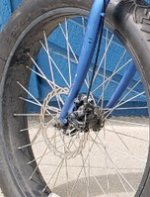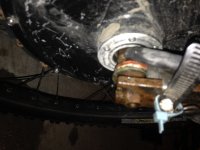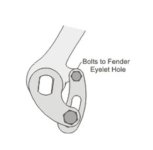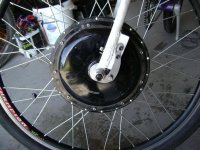Reading more closely, I get it, clamping torque arm is where its at.
Its a matter of how do I implement it, not a lot of space, doubt the angle iron picture posted would do much, because I do not have a lot of area to play with. Not sure what that style of drop out is on my fork, but not a lot of surface area on the dropout area.
If I get really thick flat plate steel, make the axle notch as tight as possible, make a relief cut (red) on the where the axle bottoms out (black notch) to get it to flex with when bolts is inserted in the threaded hole (yellow). If I get 1/2" thick steel, means the threaded part would be half that so 1/4" threaded hole. Wont be much off-cuts in the sale bin for much thicker.
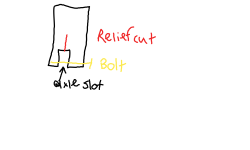
E-HP said:
Chalo said:
I think using regen or e-braking with a non-clamping torque arm is folly. But if for some reason I felt I had to do it, I'd use a jam nut locked to the outer side of the axle nut in the hope of preventing it from backing off.
Of course our opinions on regen differ, but my Grin torque arm(s), on the left side of my Leaf motor is literally a press fit. I think it would take me 10 or 15 minutes to get it all the way off, but I'm able to back is out just enough to get my wheel off when I need to. On the right side the torque arm is a tight fit, but I have it shimmed with a piece of razor blade that I can jam in with a chisel. If I start it sharp edge first, it only takes a couple of whacks to get it in far enough to take up any slack . Neither has any movement relative to the axle, and have solid anchors (no hose clamps).
I'm using slide regen so if I'm not throttling, I'm regening (but I can still use throttle for PAS or coasting, which took a couple of months of practice to become second nature). I don't set the regen high, since I primarily want energy recovery, but it's enough to slow the bike down pretty fast if I let all the way off the throttle. Never had a nut come loose or move. Clamping is ideal, but as long as torque arms are a tight fit and have a solid anchor, then I don't see an issue.
Front
E-HP said:
A bit confusing but I will pay attention more closely and read better.
2 nuts, one large, one thinnner.
So lets get this straight, I got the forks dropout metal whether it be steel or aluminum or cf or titanium.
The axle slips into the slot.
Normally you either use a washer with a nut or just a nut or a flange nut with or without a washer.
I dont do a washer, I tighten the nuts on both sides.
Slip on my ta's and secure them.
What you guys are saying is I can use two nuts, if I have the luxury of a long axle. One wider nut, one thinner nut.
Its the orientation and the amount of torque you apply to each.
Dropout then thin nut then wider nut or dropout then wider nut then thinner nut.
That just cant happen I do not have enough room on the axle for that.
My plan of attack is to get 1/2" to 3/4" off-cut in the sale bin. Do as pictured.
I'd feel more secure when riding, slow as I do, to have some thread left to use a nut. TA's got to be spot on tight with no play.
I remember the debate of hardened tool steel vs regular old steel. The thought was tool steel could damage the axle because the tool steel gives zero play in the steel itself. Whereas the regular steel (hot/cold) has a bit of give to it, yes one hot/cold has more give then the other. Tool steel I can only imagine is expensive, no clue, maybe double or triple? harder to work with tool steel, tap and cut holes.
I like the idea of shimming, never would have crossed my mind to shim with a razor blade, but it makes sense.
I dont know if the cheap generic controllers with e-braking high with the other option being e-braking low if thats considered regen, to me regen would be a feature you pay more for. All I know is when I used it, I did get a bit less distance as when e-braking high or low is engaged it uses some power. I just have short hills, excellent for saving on pads, then I am only using the brake pads at the very end to stop, as by that time the e-braking doesnt have enough force to do it like it did at the top of the hill. e-braking needs rpm to engage with a high braking force, as the rpm decreases there becomes less and less braking force to when I am at 1mph its non-existant braking force, which is where the pads come in to stop.
I am sure if I had regen, I would net 5% maybe 10% additonal battery juice. Yes the Phase Runner would be cool, a neat and slim controller but its expensive. Could play with all its features and still be clueless.
99t4 said:
Chalo said:
...I'd use a jam nut locked to the outer side of the axle nut in the hope of preventing it from backing off.
Good idea, thank you for that.
Just in case there's any confusion about where the jam (thin) nut should go, it should go on first, contrary to "common sense" opinion.
"Tightening one nut down and then simply tightening another nut on top of it achieves little locking effect. A specific procedure needs to be followed if locking is to be achieved. When a thin and thick nut are used, it may be thought that the thick nut should go next to the joint since this would take the entire load. However, by placing the thin nut on first, when the thick nut is tightened on top of it, the load on the threads of the thin nut are relieved of their load.
The thin nut should be placed on the bolt first. This nut is typically tightened to between 25% to 50% of the overall tightening torque. The second (thick) nut is then placed on the bolt and the thin nut held to prevent rotation by a spanner whilst the thick nut is tightened to the full torque value."
From https://www.boltscience.com/pages/twonuts.htm
E-HP said:
99t4 said:
The thin nut should be placed on the bolt first. This nut is typically tightened to between 25% to 50% of the overall tightening torque. The second (thick) nut is then placed on the bolt and the thin nut held to prevent rotation by a spanner whilst the thick nut is tightened to the full torque value."
From https://www.boltscience.com/pages/twonuts.htm
Pretty cool. So does tightening the jam nut to 50%, then the main nut to 100% achieve the same clamping force on the dropout as just the main nut to 100%? Seems like it would.
Chalo said:
99t4 said:
Chalo said:
...I'd use a jam nut locked to the outer side of the axle nut in the hope of preventing it from backing off.
Good idea, thank you for that.
Just in case there's any confusion about where the jam (thin) nut should go, it should go on first, contrary to "common sense" opinion.
Yeah, but if it's a flanged nut you're trying to lock, that doesn't work.




